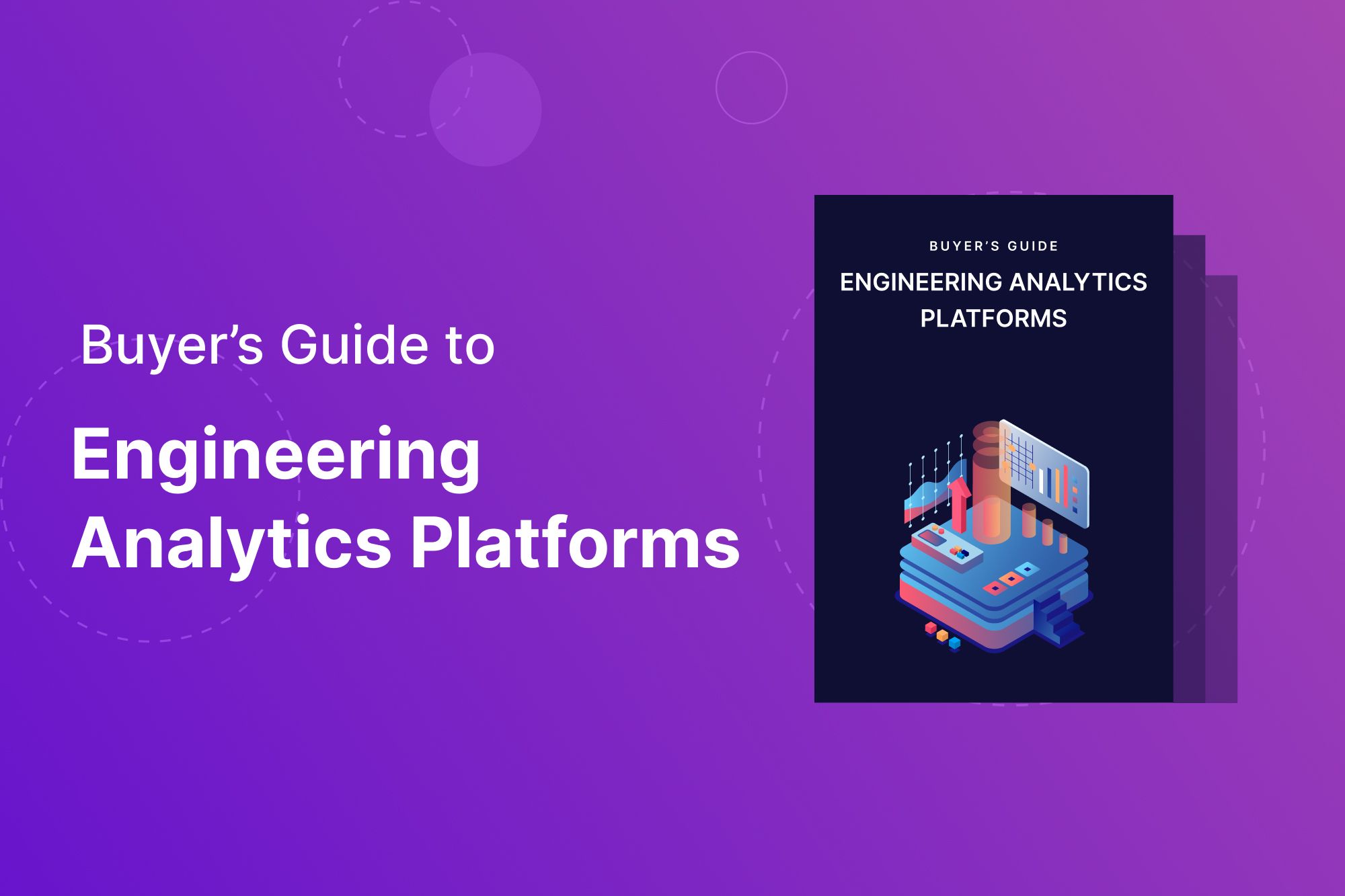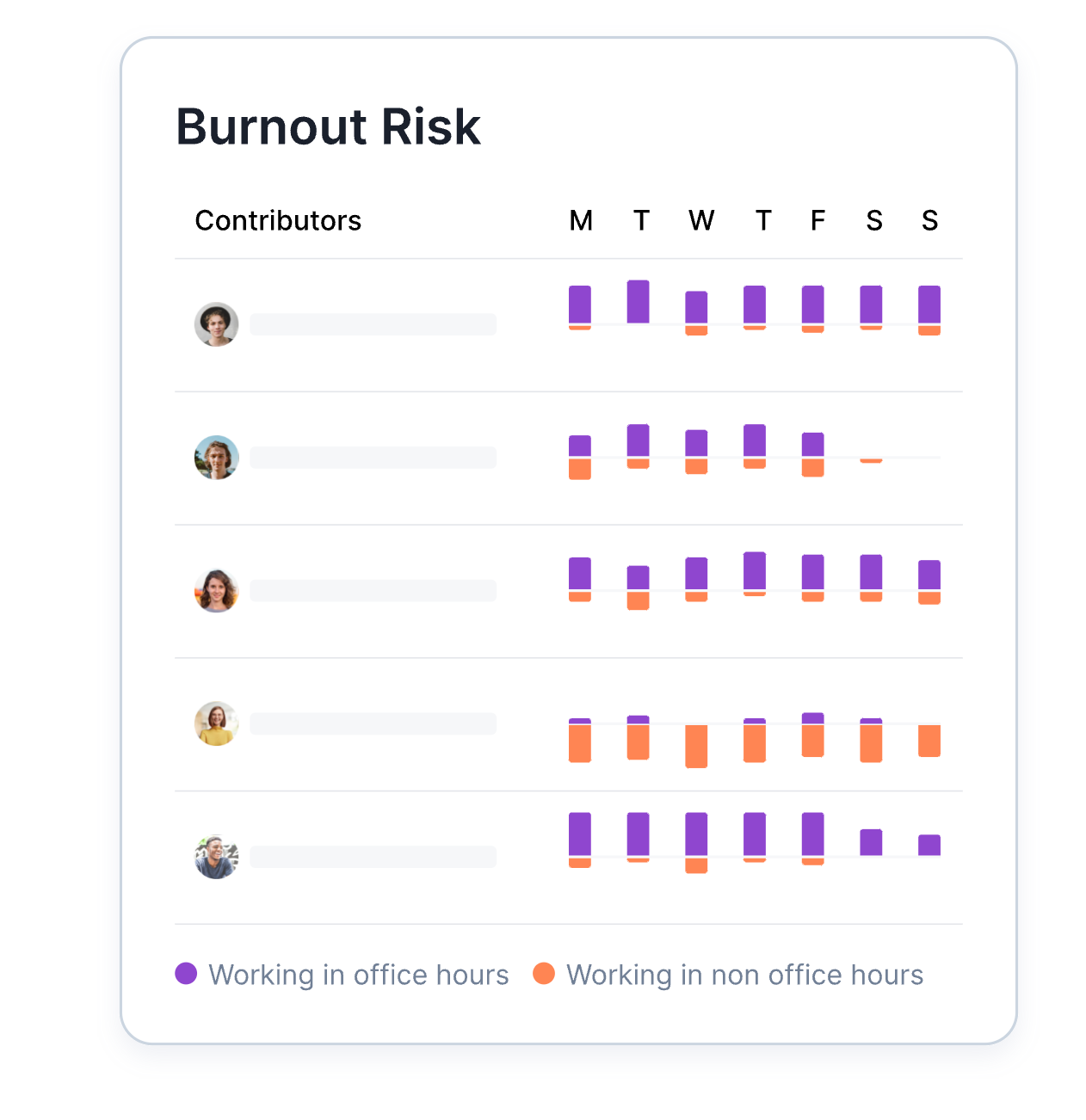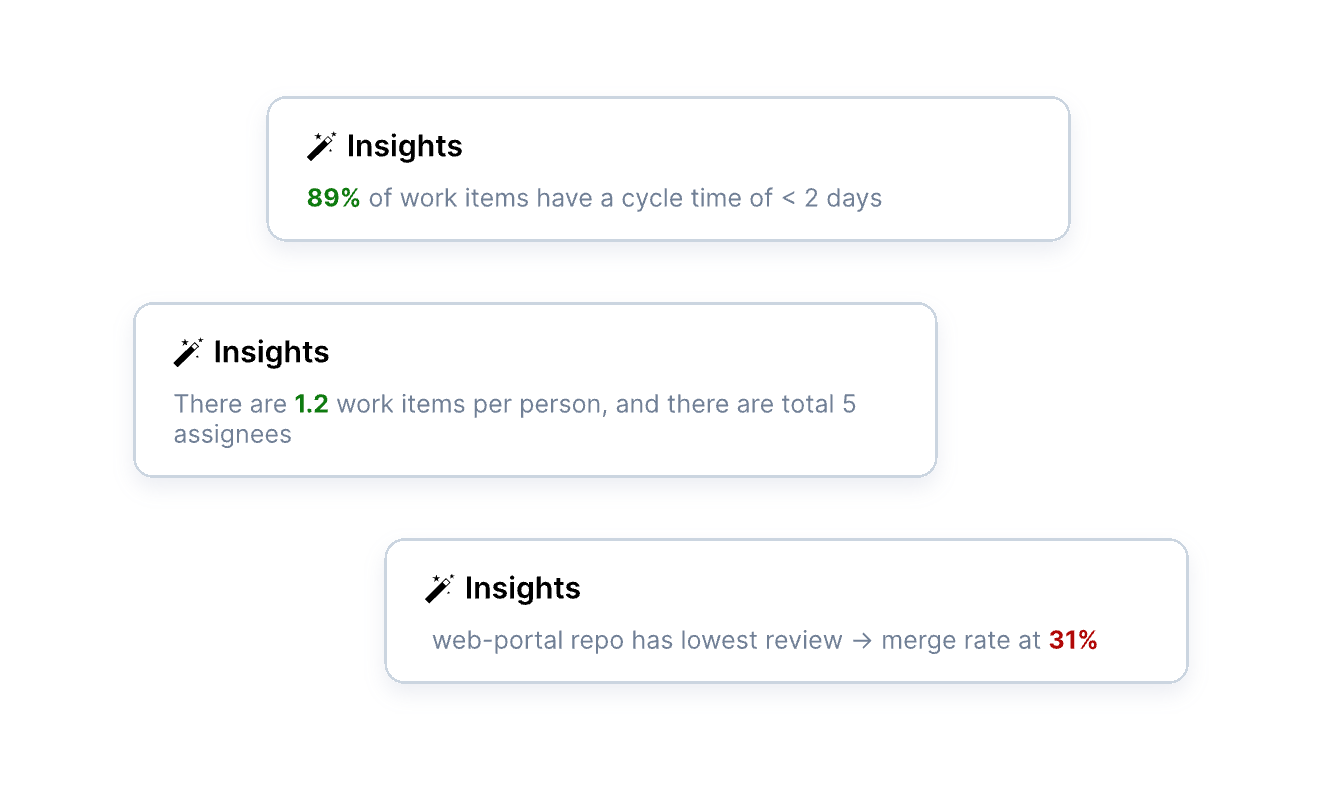A buyer’s guide to engineering analytics platforms

Engineering leaders play a key role in driving transformational changes within their organizations. Tasked with spearheading innovation, delivering new features, ensuring a collaborative work environment, and achieving operational excellence, engineering leaders face relentless pressure.
Navigating this landscape is fraught with challenges. Despite possessing highly skilled engineering teams, leaders often encounter obstacles in ensuring that these teams remain aligned with strategic priorities. The task of identifying the right levers to enhance team and operational performance is daunting, especially within larger organizations or those comprising distributed teams.
Achieving clarity on the health of teams and the efficiency of processes becomes increasingly complex as teams expand and their toolsets grow more sophisticated. This complexity hinders the ability to closely link engineering efforts with business objectives, to identify leading indicators of key initiatives' progress, and to articulate the value of engineering activities effectively.
Significant investments in technology do not always result in anticipated productivity gains. There is a disconnect between technology adoption and tangible improvements in operational efficiency, posing a conundrum for engineering leaders striving to drive meaningful change.
The Productivity Paradox presents a significant challenge to engineering leaders at the forefront of integrating new technologies within their teams and workflows. Despite substantial investments in cutting-edge software tools, platforms, and methodologies to boost efficiency and productivity, the expected improvements often do not materialize as anticipated.
The crux of overcoming these challenges lies in harnessing the power of data. Data is indispensable for attaining the visibility necessary to make informed organizational decisions. Yet, the valuable insights leaders require are often scattered across disparate tools. It requires extensive effort to compile, cleanse, and analyze—transforming raw data into actionable insights, which can be both time-consuming and error-prone.
Engineering analytics platforms address these problems head-on by empowering leaders to translate vast data into coherent insights that facilitate decision-making and action. In doing so, they instill confidence in engineering teams' ability to execute and deliver innovations that propel the business forward. As the capabilities of these platforms continue to evolve, they become indispensable tools for engineering leaders committed to navigating the complexities of modern software development and achieving transformational change.
In the guide, we'll explore why engineering analytics solutions are necessary to anticipate and adapt to engineering teams' needs. We’ve also developed a holistic framework for evaluating your platform’s selection based on your organization’s contextual requirements.
What is an engineering analytics platform?
An Engineering Analytics Platform, also known as an Engineering Management Platform (EMP), is designed to help engineering leaders track, analyze, and improve their development processes and outcomes. Engineering analytics platforms gather data from disparate sources to provide visibility into an engineering team’s software development lifecycle. By analyzing this data, EA Platforms provide visibility into team performance, code quality, project progress, and more. EA Platforms equip leaders with data-driven insights to make informed decisions, ensure alignment with business goals, and overcome organizational challenges.
A comprehensive engineering analytics platform offers insights into:
- Engineering velocity
- Code quality
- Team health
- Deployment efficiency
- Team/developer health
- Resource allocation
Engineering leaders can leverage these insights to implement data-driven strategies that maximize engineering impact.
Why do you need an engineering analytics platform?
In modern software engineering, intuition and experience, though invaluable, are no longer sufficient to steer the ship. The complexity and volume of projects demand data-driven decision-making. EA Platforms step in to fill this gap, offering a clear, empirical basis for decisions that affect the future of projects, teams, and the business itself.
By transforming raw data into actionable insights, EA Platforms enable teams to refine their processes, enhance productivity, and elevate the quality of their software. EA platforms are not just helpful but necessary. Here’s what makes it an indispensable tool:
- Enhanced visibility: EA platforms provide a 360-degree view of your SDLC. This visibility is crucial for identifying bottlenecks, understanding team dynamics, and tracking progress toward goals.
- Improved decision-making: Access to actionable data enables engineering to make informed decisions that align with the team's objectives and the company's strategic goals.
- Increased productivity and efficiency: By highlighting inefficiencies and pinpointing areas for improvement, EA Platforms help teams streamline their workflows. This can lead to significant gains in productivity, as teams can focus on what they do best: building great software.
- Better quality assurance: Quality is paramount in software development. EA Platforms help maintain high standards by providing insights into code quality, technical debt, and bug frequency. Teams can proactively address issues, leading to more reliable and robust software.
- Alignment with business goals: By tracking and analyzing engineering efforts in the context of business objectives, engineering leaders can ensure that their team’s work contributes directly to the company's strategic goals.
- Preventative maintenance: Insights into code health allow teams to address potential problems before they become critical, reducing the risk of significant issues or system failures.
- Team performance: Engineering analytics enable leaders to track key performance indicators (KPIs) for their teams, providing a clear picture of team efficiency, productivity, and areas for improvement.
- Continuous improvement: The insights provided by engineering analytics create feedback loops that teams can use to monitor and adjust their practices continuously, fostering a culture of continuous improvement.
Options in the market
The market offers a variety of EA Platforms, each with distinct features aimed at solving specific challenges within engineering leadership. While some platforms focus on engineering metrics and process optimization or developer experience, holistic EA Platforms like DevDynamics provide a full suite of tools designed to support complex organizations' unique technology and security needs.
Many organizations still use in-house solutions like spreadsheets and manual methods to track metrics and collate insights. While spreadsheets offer a certain level of flexibility and immediate accessibility, they come with significant drawbacks:
- They are prone to errors
- Maintaining and updating spreadsheets is time-consuming
- Spreadsheets often fail to provide real-time data,
- They have limited scalability
- Managing sensitive data in spreadsheets can pose security risks
In contrast, comprehensive EA Platforms like DevDynamics are designed to overcome these challenges by automating data collection and analysis, providing scalable and secure solutions for managing engineering data. These platforms enable teams to move beyond the limitations of spreadsheets, offering dynamic dashboards, real-time alerts, and actionable insights that drive efficiency, innovation, and alignment with business objectives.
Choosing the right EA platform
When selecting an engineering analytics platform, aligning your choice with your organization's unique requirements and ambitions is crucial.
This guide offers a structured approach for evaluating EA platforms, focusing on seven critical areas of functionality to consider:
Efficiency & delivery
After engineering leaders establish strategic priorities and appropriately designate resources for these initiatives, ensuring the software development pipeline goes efficiently is imperative. However, multiple roadblocks might throw the project off course, such as unexpected technical issues, changes in project scope, and revisions. To ensure efficient software delivery, timely detection of bottlenecks is necessary to counter them beforehand and avoid delays.
Key capabilities for assessing efficiency & delivery:
Real-Time alerts for proactive issue resolution: An EA Platform should be able to flag potential issues early with real-time alerts. This feature helps identify work that might derail the current sprint, enabling leaders to support developers effectively, enforce coding best practices, and keep projects moving smoothly. The ability to customize alerts according to team norms and integrate them with preferred communication systems (e.g., email, Slack) ensures that leaders can address issues promptly.
Visualization and team trends analysis: Clear visualization of activity and the ability to assess the distribution of work across the team are highlighted as important factors for an EA Platform. This aids leaders in balancing workloads, identifying developers who might need extra support or are at risk of burnout, and optimizing team performance. Understanding team trends and setting targets based on historical data and industry benchmarks can help leaders scale best practices and support teams effectively.
Adaptability to CI/CD and DevOps metrics: Especially for organizations adopting CI/CD methodologies, the platform's capability to cater to DevOps metrics (e.g., Lead Time, Deployment Rate, and average time to resolution) is essential. This ensures that any workflow friction is quickly identified and addressed, maintaining a smooth and efficient delivery process.
Velocity metrics: EA Platforms with built-in velocity metrics tracking are crucial in assessing the speed and efficiency of software delivery. These metrics provide insights into sprint completion rates, deployment frequency, and the balance between planned versus completed work. The platform helps identify bottlenecks and streamline workflows by tracking cycle and lead times. Effectively using velocity metrics allows leaders to optimize team performance, ensuring projects stay on track and resources are utilized effectively. Ultimately, these insights drive continuous improvement and align engineering efforts with strategic goals.
Resource allocation
Even the most skilled engineering teams can steer off the path without proper resource allocation. The real impact of engineering teams hinges on focusing efforts on strategic priorities and effectively communicating their contributions to broader business goals. Bridging the gap between engineering work and business value involves complex data ingestion from various sources like version control, project management, and communication tools. This task, often manual and cumbersome without the right tools, leaves engineering leaders juggling between gut feelings and intricate, error-prone spreadsheets, making it challenging to gauge actual resource allocation towards maintenance, customer issues, or new developments.
Adopting it enables you to extract and analyze accurate data to guide decision-making and measure the engineering team's achievements.
Key capabilities for assessing resource allocation:
Connecting engineering work to business goals: EA Platforms have the capability to integrate engineering activities with business initiatives. This connection is crucial for ensuring that engineering efforts directly contribute to achieving strategic goals. Platforms that facilitate linking coding activities to business artifacts enable leaders to clearly understand and demonstrate the impact of engineering on key business outcomes.
Insightful allocation and capacity planning: A shared understanding of how engineering time and effort are allocated is fundamental. Effective resource allocation means having a detailed insight into the distribution of work and ensuring that the highest-priority projects are adequately resourced. This includes automating the gathering, cleaning, and analyzing data from diverse sources, providing a comprehensive view of engineering efforts, and enabling informed decision-making regarding resource distribution.
Support for key performance indicators (KPIs): Setting impactful KPIs and tracking progress toward these goals is vital for aligning engineering impact with business priorities. The best EA platforms allow for the customization of these targets and offer deep dives into the data behind progress. This functionality aids in identifying areas where teams may fall short, facilitating adjustments to processes or goals to meet business objectives better.
Real-time alerts and visualization: Real-time alerts highlighting deviations from expected progress and clear visualizations of team activities help leaders promptly identify and address issues. These features support leaders in maintaining alignment by ensuring that key initiatives are prioritized and that scope creep or unplanned work is managed effectively.
Industry benchmarks and historical data: Access to industry benchmarks and the ability to ingest historical data are important for setting realistic goals and understanding long-term trends. Platforms that offer these capabilities provide a richer context for assessing team performance and aligning engineering efforts with business objectives.
Team performance
Team performance is not about the speed at which your team delivers work; it’s also about ensuring high-quality output. A comprehensive engineering analytics platform should evaluate team effectiveness, distinguishing it from resource allocation or productivity. This involves understanding the extent of unnecessary work, such as tracking the volume of unreviewed pull requests or the balance between new code and refactoring.
Effectiveness metrics, including code review quality indicators like code coverage, prevent subpar code from proceeding to production, foster continuous improvement, and facilitate knowledge sharing within the team. Evaluating team performance is essential for understanding not just the productivity of your engineering teams but also their overall health and well-being.
Key capabilities for assessing team performance:
Understanding team health and process metrics: Process metrics such as Time to Open, Time to Merge, Cycle Time, PR Throughput, and Review Speed are crucial for assessing the team's collaboration patterns, identifying bottlenecks, and pinpointing areas for improvement. These metrics offer a glimpse into the efficiency of your team's software development lifecycle (SDLC) processes and help optimize team workflows.

DORA metrics: DORA metrics (Deployment Frequency, Lead Time for Changes, Change Failure Rate, Mean Time to Recovery) provides a standardized method to measure and communicate team health. These metrics balance speed with quality and agility, offering insights into the team's performance relative to industry standards and organizational goals. Evaluating an EA Platform's ability to measure DORA metrics in the context of other insights (e.g., the impact of unreviewed PRs on the change failure rate) is also crucial for understanding and managing trade-offs in engineering practices.
Benchmarking and contextual performance analysis: The ability to benchmark team performance against industry standards and historical data is vital for setting realistic goals and understanding long-term trends. An EA Platform that offers robust benchmarking capabilities allows leaders to place their team's performance in context, identify opportunities for improvement, and celebrate successes.
Workload distribution: Ensuring an equitable distribution of coding and review tasks fosters a healthy and inclusive team environment. Platforms that provide insights into workload distribution help leaders make informed decisions to align their teams around key objectives and celebrate collective achievements.
Data-driven insights
Data-driven insights are the cornerstone of effective engineering management. They guide strategic decisions, optimize processes, and align engineering efforts with business objectives. For EA platforms to be truly impactful, they must offer precise and current data, integrating effortlessly with existing tools, from version control and project management to CI/CD pipelines, ensuring comprehensive insights.
Key capabilities for assessing data-driven insights:
Trust and accuracy in data: For an EA Platform to be truly effective, it must provide accurate and timely information. This requires seamless integration with your team's tools and systems, including VCS, project management, incident response, and CI/CD systems. Trust in the data is fundamental, underpinning all subsequent analyses and insights. The platform should automate the gathering, normalizing, and linking of data from these diverse sources, ensuring a comprehensive and reliable foundation for insights.
Flexibility and customization: The ability to customize data collection and reporting is crucial. This includes custom data exclusions to improve data quality by filtering out outliers or irrelevant information and the flexibility to adapt reports and alerts to focus on your organization's most pertinent questions and concerns. A platform's configurability ensures that insights are relevant and aligned with specific organizational needs and goals.
Contextualizing data: Data without context can be misleading. Adding annotations directly into reports and charts is invaluable, as it preserves and communicates the nuances behind the numbers. Annotations can highlight process changes, significant events, or shifts in team morale, offering a richer understanding of how these factors impact performance metrics.

Comprehensive data integration: An EA Platform should not only rely on traditional development metrics but also incorporate signals from across the entire tech stack, including non-development tools like documentation platforms and communication channels. This holistic approach to data collection provides a more accurate representation of engineering efforts, ensuring that insights reflect the full scope of team activities and collaboration patterns.
Automating complex data analysis: Beyond basic data collection, the platform should offer sophisticated analysis capabilities, such as the automated scoring and cleaning of ingested data. This ensures that insights are based on a nuanced understanding of engineering efforts, allowing for identifying trends, allocating resources, and aligning engineering work with business priorities.
Integration & adaptability
The ability of an engineering analytics platform to integrate seamlessly with existing systems and adapt to organizational changes is crucial. This ensures the smooth operation of current projects and the platform's utility as the organization grows and evolves.
Key capabilities for assessing integration & adaptability:
Adaptation to organizational structures: The platform must accommodate complex organizational setups, including multiple business units with diverse team configurations (remote, hybrid, contractors, etc.) and varying stakeholder expectations. This flexibility is key to providing valuable insights across different segments of the organization, ensuring the platform remains relevant and useful as the company scales.
APIs for data extraction and reporting: Useful APIs that enable the extraction of engineering data for integration with Business Intelligence (BI) tools used elsewhere in the organization are crucial. This feature allows users to create tailored reports to share across teams, facilitating alignment between engineering activities and broader business outcomes.
Scalability and support infrastructure: Look for platforms backed by a robust support infrastructure that extends beyond technical support to include clear guidance on data utilization from onboarding forward. This support should help teams understand how to act on insights while fostering a culture of safety and continuous improvement. The provider's ability to offer ongoing resources, training, and thought leadership reflects their commitment to your long-term success.
Security & compliance
Prioritizing basic security, such as installing a robust VPN and ensuring compliance, is essential when selecting an engineering analytics platform (EA platform). The platform must safeguard sensitive data while providing insights to drive engineering excellence.
Key capabilities for assessing security and compliance:
Source code protection: The integrity and security of your source code are paramount. An ideal engineering analytics platform should analyze data and generate insights without storing or directly accessing your source code.
SOC 2 certification: This certification is a testament to a platform's commitment to robust security practices. It involves a comprehensive, independent security audit that evaluates an organization's security, availability, and data integrity controls. SOC 2 certification assures customers of the platform's dedication to protecting user data and maintaining privacy standards.
Role-based access controls (RBAC): Balancing transparency with data security is critical in fostering a positive data-driven culture. RBAC enables organizations to manage who has access to specific information precisely. This control mechanism ensures that sensitive data, such as engineering metrics and insights, is only accessible to authorized personnel. For example, individual developers might be restricted to viewing team-level metrics only, safeguarding personal and project-specific data from wider exposure.
Compliance with regulations: Beyond internal security measures, an engineering analytics platform must also comply with relevant data protection regulations (like GDPR, HIPAA, etc., depending on your organization's location and operation scope). This compliance protects your organization from legal risks and reinforces trust among your teams and customers that their data is handled responsibly.
Data privacy and integrity: The platform should have clear policies and controls to ensure your data's privacy and integrity. This includes measures to prevent unauthorized access, data breaches, and loss of data integrity throughout the data lifecycle, from collection and storage to processing and analysis.
Time to implementation
Time to Implementation is a critical factor that can significantly impact your engineering team's productivity and the overall return on investment. This involves not just the initial setup and integration but also the ongoing maintenance and scalability of the platform.
Key capabilities for assessing time to implementation:
Ease of integration: EA platforms should seamlessly integrate your existing tools and workflows. This includes compatibility with your version control system (VCS), project management software, CI/CD pipelines, and other tools commonly used by engineering teams. Platforms that offer a wide range of native integrations or a robust API for custom integrations will typically be quicker and easier to implement.
Onboarding and training: Consider the resources provided for onboarding and training your team on the new platform. A platform that offers comprehensive documentation, interactive tutorials, and responsive customer support can significantly reduce the time it takes for your team to become proficient in using the platform.
Customization and configuration: Evaluate the level of customization and configuration required to get the platform up and running according to your needs. Platforms that offer out-of-the-box functionality with minimal setup required can be deployed more quickly, but they should also offer enough flexibility to tailor the platform to your specific requirements.
Scalability: Consider how well the platform can scale with your organization. Platforms designed to easily accommodate growth in your team size, project complexity, and data volume will require less time to adjust and scale up in the future, making them more efficient in the long term.
Automation capabilities: Platforms that leverage automation for data collection, analysis, and reporting can significantly reduce the time to implementation. Automation minimizes the need for manual setup and ongoing maintenance, allowing your team to focus on deriving insights rather than managing the tool.
Community and vendor support: The availability of a supportive community and responsive vendor support can influence the speed of deployment and problem resolution. Platforms with an active community forum, a comprehensive knowledge base, and dedicated customer success teams can help resolve issues more quickly, reducing downtime and implementation delays.
Buyer’s checklist
This checklist outlines the essential features and functionalities across core functional areas of an engineering analytics platform. It's designed to help you make the most impactful decision when selecting a platform:
About DevDynamics
DevDynamics is a holistic Engineering Analytics Platform that empowers engineering leaders to maximize the impact of engineering initiatives. By meticulously analyzing engineering activities and relevant business data, DevDynamics offers unparalleled insight into engineering teams and their projects. DevDynamics is leveraged by companies like BigBasket, PayU, and Zoomcar to drive continuous improvement.

